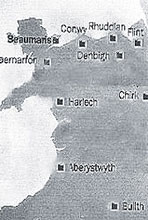Denbigh - A Concentric Castle Design
Welsh Castles including Denbigh Castle, built by Edward I, are referred to as Concentric Castles. The Gothic architecture of the Medieval era together with the design of Concentric Castles encompassed some, or all, of the following elements: - A Stronger central Keep or Main Tower
- A Round or Circular Shaped Keep
- A High wall, complete with towers surrounded the Keep and the Inner Bailey
- At least one lower, outer wall surrounded the Inner High Wall
- Several Outer Walls and Outer Baileys were often added!
- Several Gatehouses were featured
- Moats were added which surrounded the whole Concentric Castle complex
Concentric castles were bigger than any previous castles! The walls were thicker, stronger and higher with turrets! The Inner Walls were higher than Outer walls! Drawbridges were added! The interiors were more comfortable, even luxurious! Concentric Castles, like Denbigh, were very expensive! Denbigh - A Welsh Fortified Town (aka Bastide or Burgh)
Denbigh Castle was constructed in conjunction with a new, fortified town. The idea of building fortified, purpose-built townships were based on a combination of the Bastides of Gascony and the Burghs, or Burhs, built by King Alfred the Great of England. Welsh Medieval Fortified Townships. The 'Bastide' at Denbigh was a strongly defended town, the construction of which, had been subject to proper planning and architectural design. The layout of the town at Denbigh took into consideration the following defence factors: - The layout of the town's houses and buildings in Denbigh were planned so that they would not impede the circulation of troops
- The rapid movement of the troops garrisoned at Denbigh was ensured by building a main road which provided direct access to the curtain wall and the main gate and towers
- The central public square in the Denbigh township doubled as a mustering point for all troops
- Wall Towers could only be accessed from a doorway on the battlement accessed via a moveable wooden staircase on the inside of the wall
- The central public square doubled as a mustering point for all troops
- The Town wall was defended by a number of towers
- The weakest points of any building are the corners - these towers were therefore round
- Wall Towers could only be accessed from a doorway on the battlement accessed via a moveable wooden staircase on the inside of the wall
Denbigh Castle
Denbigh Castle was one of the ten key Welsh Medieval Castles which were commissioned by King Edward I. The Welsh Medieval Castles built by the English under the direction of King Edward I provided a power base for the Medieval Plantagenet King and ensured that the Welsh were subservient to the new English rule. |

